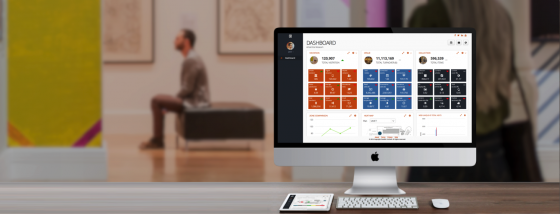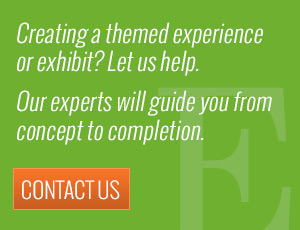Technology for Art: An Inside Look at Developing Tools for Cultural Institutions
Posted by Sasha Bailyn on Monday, October 3rd, 2016

“If data isn’t high on a museum’s agenda, it should be. Insight can make a 10x difference to cultural institution outcomes, across funding, visitation, investment, efficiency and innovation. Neglecting it is akin to missing out on the digital revolution,” says Angie Judge, CEO of the museum and cultural institution-focused platform Dexibit. Dexibit’s team is leading a movement to create analytical tools that are deeply customized for the cultural institution context and provide real value for museum leaders.
Curators and museum management are increasingly looking for the right tech tools to better quantify the visitor experience, to manage their collections, and to develop strategies that help them address critical funding gaps. Companies are jumping in to create virtual reality apps and full-scale analytics programs that accomplish all these goals. Yet most of the conversation in this space focuses on how museums are using tools to engage visitors. What’s it like for the companies that are designing these tools, and what does it take to create effective technology products for the museum space and beyond?
One of the most important elements is understanding the problem you’re solving: a lack of timely data delivery to the people who are making critical decisions about collections, staffing and funding. “Most museums spend at least several months on data administration, waiting a long time for data to reach decision makers and are only able to access limited insight. Cultural institutions need rapid insights into visitor behavior – this could be for raising funds, deciding an upcoming schedule or evaluating campaign performance for example,” says Judge.

With more complete insights, it’s possible to begin a culture shift that moves from safe and simple techniques like clicker counting to integrating dynamic data into the decision-making process. From there, data integration – and its impact – is next level. “We’re establishing the foundations for the cultural sector to leverage data assets for innovation – such as personalization to advance visitor experience,” notes Judge.
In many ways, successful data strategies start with understanding the visitor experience. Data collection has always been a segmented process for cultural institutions, from lengthy surveys to clicker-counting people at the door. What guests achieved prior to visiting the institution, what they did while they were there, and how they engaged following their visit, are all important data sets that need to be analyzed together. The goal is a holistic view of what customers are experiencing, and how internal and external factors influence those behaviors and contexts.
“To understand a complete picture of visitor behavior, we needed to see the visitor’s experience before, during and after their visit, onsite and online, over any channel – and all in one place, so we can blend data together. This is critically important because online and onsite experience aspects are interrelated rather than distinct. Just looking at ticketing reports, for example, or website traffic, would only tell us one part of the visitor’s story,” explains Judge. “We also needed to understand what external influences – like weather – might be impacting the visitor journey too. Dexibit automatically senses visitor presence after they come through the door – what galleries they activate, how long they spend in each, what trail routes they take, and if they repeat their visit.”
After collecting information, it’s important that analytics tools for the sector combine the data in ways that are relevant to the museum industry. One critical aspect is better segmentation and a deeper understanding of customer needs. “When we look at clustering behavior, it provides a completely different segmentation on how people experience the museum. It’s a whole new level of insight for museum managers to be making decisions with, on everything from wayfinding through to content, scheduling and more.”

In order to create effective technology for the museum space, the Dexibit team realizes it requires a fully integrative progression and investment in cultural change. Judge notes that the company offers a data concierge service that sees companies through the entire process, from explaining the very foundation of analytics to making advanced management decisions based on the big data collected.
It’s not enough to just create the technology and hope it makes a difference. A company that designs for cultural institutions must understand that it is a transformative process that generally requires advisory services onboard. Dexibit’s concierge service guides people through the cultural change required when they adopt these new types of technology.
From a design and developmental perspective, Judge muses that some of the biggest challenges Dexibit helps companies solve are taking the pain out of reporting and removing any guesswork from decision making. Data collection has always been a tedious process for museums, and when it is done manually it is generally not accurate by the time it reaches decision makers.
Cultural institutions can now use real-time data through technology like Dexibit’s to make on-the-spot decisions that will have an immediate impact on the visitor experience. Rapid insights into visitor behavior can benefit an organization in a variety of ways, such as:
- Scheduling
- Raising funds
- Evaluating campaign performance
- Staffing
- Collections management and content decisions
Understanding what the pain points are for an organization not only helps to create a solution, but also allows an institution to leverage data assets for innovation. This includes advancing user experience through personalization and creating unique engagement opportunities. In order to design for the museum space, a company must first understand their particular digital landscape and business priorities. Comprehending the data world of an institution means assessing how information integrates across the specific museum. Dexibit has developed an insight methodology to help establish data-driven operations, while also putting heavy emphasis on the user experience.
Once challenges are fully understood, advanced technology such as analytics can be applied to help resolve these issues. Judge maintains that Dexibit’s success has to do with the groundwork they put into their personas research, tracing decisions, and insight for key management roles within the museum context. When all of this data is consolidated into a user-friendly dashboard, implementation and reporting become much simpler tasks.
Looking ahead to the future of data-driven insights business for the museum space, we’ve just scratched the surface on what’s possible. The potential isn’t always about designing new technologies for this space; sometimes it’s about combining what you already have. Convergence is the next step in museum technology. It doesn’t stop with integrating data sets, either – it’s about open-source technology and an analytics landscape enabled by the cloud. It spans beyond simply collecting and combining information.
Trends including predictive analytics, machine learning, and cognitive computing are at the forefront of the digital evolution for cultural institutions. As Judge adds: “We’ll see a form of convergence in how we collaborate with data, too – empowering everyone in the museum together, rather than locking down data access to a technical analyst or two. This should be front of mind for any industry executive right now.”
As a final thought, Judge stresses the importance of data-driven insight for cultural institutions. If data collection and analysis is not a priority for a museum, it should be. Integrating technology as a solution has proven to generate positive outcomes in this creative space. From funding to investment, visitation and innovation, big data has a profound effect on cultural institutions. In many ways, it’s a process that shouldn’t be attempted alone. “To get the most from analytics, the museum’s response needs to be more than just a tooling opportunity and requires cultural change that impacts organization wide.”
Entertainment designers and app developers who are interested in this space can learn a lot from Dexibit, from the power of a laser-like focus on a clear customer segment to realizing that the analytics needs of organizations vary. Invest the time to understand how real-time data and analytics can transform all elements of a cultural institution and guest experience – and then work with the right partners and an engaged team to create and implement the tools to support that bigger vision.
Images provided courtesy of Dexibit



 Sign Up For Our Newsletter
Sign Up For Our Newsletter 



